JVC KD-PDR50, KD-APD58 User Manual
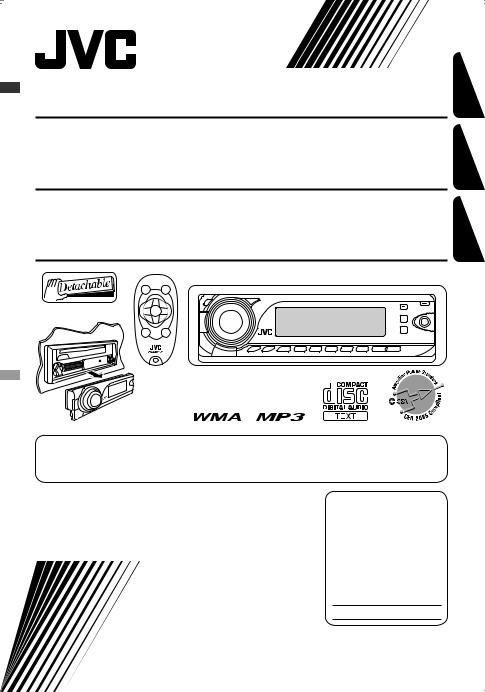
CD RECEIVER
RECEPTOR CON CD
RÉCEPTEUR CD
KD-APD58/KD-PDR50
KD-APD58/KD-PDR50
KD-APD58/KD-PDR50
FRANÇAIS ESPAÑOL ENGLISH
For canceling the display demonstration, see page 6.
Para cancelar la demostración en pantalla, consulte la página 6.
Pour annuler la démonstration des affichages, référez-vous à la page 6.
For installation and connections, refer to the separate manual. Para la instalación y las conexiones, refiérase al manual separado.
Pour l’installation et les raccordements, se référer au manuel séparé.
INSTRUCTIONS
MANUAL DE INSTRUCCIONES
MANUEL D’INSTRUCTIONS
For customer Use:
Enter below the Model No. and Serial No. which are located on the top or
bottom of the cabinet. Retain this information for future reference.
Model No.
Serial No.
GET0425-001A
[J]

ENGLISH
Thank you for purchasing a JVC product.
Please read all instructions carefully before operation, to ensure your complete understanding and to obtain the best possible performance from the unit.
INFORMATION (For U.S.A.)
This equipment has been tested and found to comply with the limits for a Class B digital device, pursuant to Part 15 of the FCC Rules. These limits are designed to provide reasonable protection against harmful interference in a residential installation. This equipment generates, uses, and can radiate radio frequency energy and, if not
installed and used in accordance with the instructions, may cause harmful interference to radio communications. However, there is no guarantee that interference will not occur in a particular installation. If this equipment does cause harmful interference to radio or television reception, which can be determined by turning the equipment off and on, the user is encouraged to try to correct the interference by one or more of the following measures:
–Reorient or relocate the receiving antenna.
–Increase the separation between the equipment and receiver.
–Connect the equipment into an outlet on a circuit different from that to which the receiver is connected.
–Consult the dealer or an experienced radio/TV technician for help.
Caution:
Changes or modifications not approved by JVC could void the user’s authority to operate the equipment.
IMPORTANT FOR LASER PRODUCTS
1.CLASS 1 LASER PRODUCT
2.CAUTION: Do not open the top cover. There are no user serviceable parts inside the unit; leave all servicing to qualified service personnel.
3. |
CAUTION: (For U.S.A.) |
Visible and/or invisible class II laser radiation when open. Do not stare into beam. |
|
(For Canada) |
Visible and/or invisible class 1M laser radiation when open. Do not view directly with |
|
|
optical instruments. |
4. |
REPRODUCTION OF LABEL: CAUTION LABEL, PLACED OUTSIDE THE UNIT. |
|
[European Union only]
Warning:
If you need to operate the unit while driving, be sure to look ahead carefully or you may be involved in a traffic accident.
For safety...
•Do not raise the volume level too much, as this will block outside sounds, making driving dangerous.
•Stop the car before performing any complicated operations.
Temperature inside the car...
If you have parked the car for a long time in hot or cold weather, wait until the temperature in the car becomes normal before operating the unit.
2
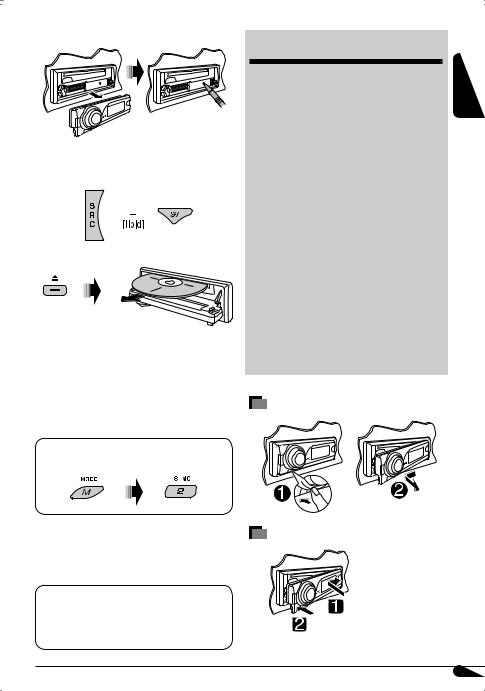
 How to reset your unit
How to reset your unit
• Your preset adjustments will also be erased.
 How to forcibly eject a disc
How to forcibly eject a disc
“PLEASE” and “EJECT” appear alternately on the display.
•Be careful not to drop the disc when it ejects.
•If this does not work, reset your unit.
 How to use the M MODE button
How to use the M MODE button
If you press M MODE, the unit goes into functions mode, then the number buttons and 5/∞buttons work as different function buttons.
Ex.:When number button 2 works as
MO (monaural) button.
CONTENTS |
|
Control panel — KD-APD58/KD-PDR50 ........ |
4 |
Remote controller — RM-RK50 ............. |
5 |
Getting started................................ |
6 |
Basic operations................................................... |
6 |
Radio operations ............................. |
7 |
Disc operations................................ |
8 |
Playing a disc in the unit ..................................... |
8 |
iPod operations ............................... |
10 |
Sound adjustments.......................... |
12 |
General settings — PSM .................. |
13 |
External component operations ....... |
15 |
Title assignment.............................. |
15 |
More about this unit ........................ |
16 |
Maintenance ................................... |
20 |
Troubleshooting.............................. |
21 |
Specifications.................................. |
23 |
Detaching the control panel |
|
ENGLISH
To use these buttons for their original functions |
Attaching the control panel |
|
again after pressing M MODE, wait for 5 seconds |
||
|
||
without pressing any of these buttons until the |
|
|
functions mode is cleared or press M MODE again. |
|
KD-APD58 is equipped with the steering wheel remote control function.
• See the Installation/Connection Manual (separate volume) for connection.
3

ENGLISH
Control panel — KD-APD58/KD-PDR50
Parts identification
Display window
1 SRC (source) button
2 B BAND button
3


 (standby/on attenuator) button / Control dial
(standby/on attenuator) button / Control dial
4 SEL (select) button
5 Display window
6 5(up) / ∞(down) buttons
7 EQ (equalizer) button
8 0(eject) button
9 AUX (auxiliary) input jack
p  (control panel release) button q D DISP (display) button
(control panel release) button q D DISP (display) button
w M MODE button
e MO (monaural) button
r SSM (Strong-station Sequential Memory) button t Number buttons
y RPT (repeat) button u RND (random) button
i  4/¢
4/¢ buttons
buttons
o Remote sensor
DO NOT expose the remote sensor to strong light (direct sunlight or artificial lighting).
; S.BASS (super bass) indicator a DISC indicator
sDisc information indicators—
TAG (Tag information),  (folder),
(folder), (track/file)
(track/file)
dSound mode (iEQ: intelligent equalizer) indicators —USER, ROCK, CLASSIC, POPS, HIP HOP, JAZZ
•  lights up for the selected item.
lights up for the selected item.
fTuner reception indicators—MO (monaural), ST (stereo)
g EQ (equalizer) indicator
h Playback mode / item indicators— RND (random),
 (disc),
(disc), (folder), RPT (repeat) j Main display
(folder), RPT (repeat) j Main display
k Tr (track) indicator
l Source display / Time countdown indicator
4
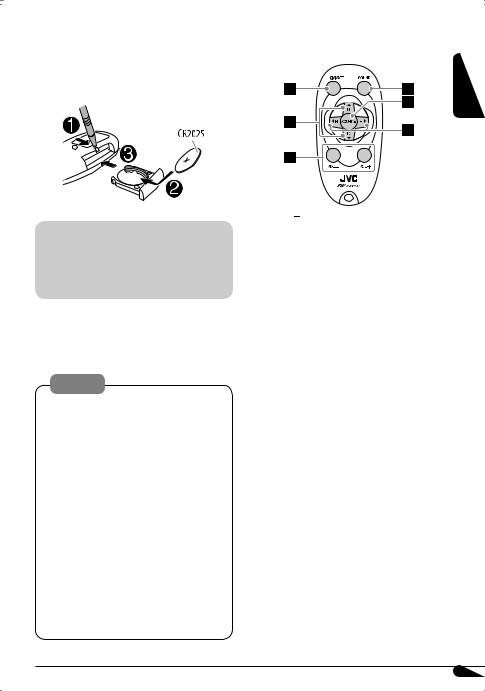
Remote controller — RM-RK50 |
|
Main elements and features |
|
|
|
 Installing the lithium coin battery (CR2025)
Installing the lithium coin battery (CR2025)
ENGLISH
For USA-California Only:
This product contains a CR Coin Cell Lithium Battery which contains Perchlorate Material—special handling may apply.
See www.dtsc.ca.gov/hazardouswaste/perchlorate
Aim the remote controller directly at the remote sensor on the unit. Make sure there is no obstacle in between.
Warning:
•Do not install any battery other than CR2025 or its equivalent; otherwise, it may explode.
•Do not leave the remote controller in a place (such as dashboards) exposed to direct sunlight for a long time; otherwise, it may explode.
•Store the battery in a place where children cannot reach to avoid risk of accident.
•To prevent the battery from over-heating, cracking, or starting a fire:
–Do not recharge, short, disassemble, heat the battery, or dispose of it in a fire.
–Do not leave the battery with other metallic materials.
–Do not poke the battery with tweezers or similar tools.
–Wrap the battery with tape and insulate when throwing away or saving it.
1
 (standby/on/attenuator) button
(standby/on/attenuator) button
•Turns the power on if pressed briefly or attenuates the sound when the power is on.
•Turns the power off if pressed and held. 2 5U (up) / D (down) ∞buttons
•Changes the FM/AM bands with 5U.
•Changes the preset stations with D ∞.
•Changes the folder of the MP3/WMA discs.
•While listening to an Apple iPod:
–Pauses or resumes playback with D ∞.
–Enters the main menu with 5U.
(Now 5U/D ∞/2R/F 3work as the menu
selecting buttons.)*
3VOL – / VOL + buttons
•Adjusts the volume level. 4 SOUND button
•Selects the sound mode (iEQ: intelligent equalizer). 5 SOURCE button
•Selects the source.
62R (reverse) / F (forward) 3buttons
•Searches for stations if pressed briefly.
•Fast-forwards or reverses the track if pressed and held.
•Changes the tracks if pressed briefly.
•While listening to an iPod (in menu selecting mode):
–Selects an item if pressed briefly. (Then, press D ∞to confirm the selection.)
–Skips 10 items at a time if pressed and held.
*5U : Returns to the previous menu. D ∞ : Confirms the selection.
5

Getting started
ENGLISH |
Basic operations |
|
|
|
|
|
~ Turn on the power. |
|
Ÿ 
*1 You cannot select “CD” as the playback source if there is no disc in the unit.
*2 “NO IPOD” appears if iPod is not connected.
! For FM/AM tuner
⁄ Adjust the volume.
Volume level appears.
@Adjust the sound as you want. (See page 12.)
Caution on volume setting:
Discs produce very little noise compared with other sources. Lower the volume before playing a disc to avoid damaging the speakers by the sudden increase of the output level.
To drop the volume in a moment (ATT)
To restore the sound, press the button again.
To turn off the power
Basic settings
•See also “General settings — PSM” on pages 13 and 14.
1 


 2
2
1Canceling the display demonstrations
Select “DEMO,” then “DEMO OFF.”
2Setting the clock
Select “CLOCK H” (hour), then adjust the hour. Select “CLOCK M” (minute), then adjust the minute.
3 Finish the procedure.
To check the current clock time while the power is turned off
Clock time is shown on the display for about 5 seconds. See also page 13.
6
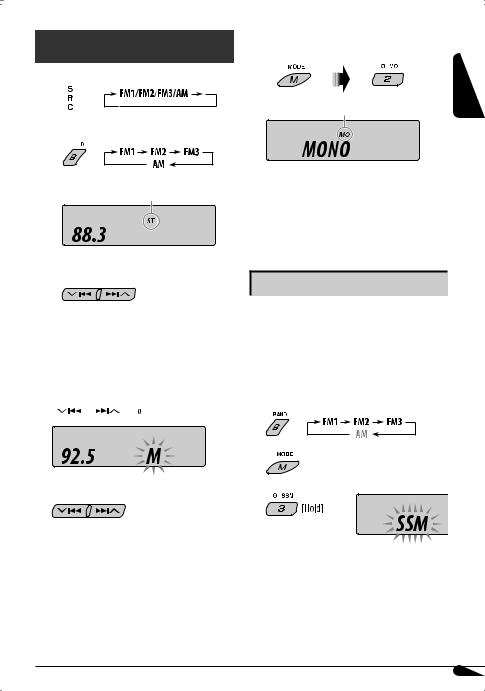
Radio operations
~ 
Ÿ 

Lights up when receiving an FM stereo broadcast with sufficient signal strength.
! Start searching for a station.
When a station is received, searching stops. To stop searching, press the same button again.
To tune in to a station manually
In step !above...
1 


When an FM stereo broadcast is hard to receive
Lights up when monaural mode is activated. |
ENGLISH |
|
Reception improves, but stereo effect will be lost.
To restore the stereo effect, repeat the same procedure. “MONO OFF” appears and the MO indicator goes off.
Storing stations in memory
You can preset six stations for each band.
 FM station automatic presetting— SSM (Strong-station Sequential Memory)
FM station automatic presetting— SSM (Strong-station Sequential Memory)
1Select the FM band (FM1 – FM3) you want to store into.
2 Select a desired station frequency.
2
3
“SSM” flashes, then disappears when automatic presetting is over.
Local FM stations with the strongest signals are searched and stored automatically in the FM band.
7
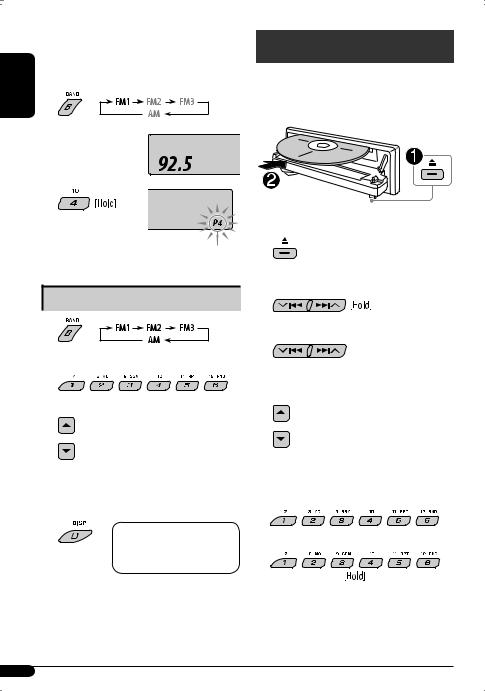
 Manual presetting
Manual presetting
Ex.: Storing FM station of 92.5 MHz into preset
ENGLISH |
number 4 of the FM1 band. |
|
|
|
1 |
2 
3
Preset number flashes for a while.
Listening to a preset station
1
2Select the preset station (1 – 6) you want.
or
To check other information while listening to the radio
Clock =Station name* =
Frequency =(back to the beginning)
*If no name is assigned to a station, “NO NAME” appears. To assign a title to a station, see page 15.
Disc operations
Playing a disc in the unit 
All tracks will be played repeatedly until you change the source or eject the disc.
To stop play and eject the disc
•Press SRC to listen to another playback source.
To fast-forward or reverse the track
To go to the next or previous tracks
To go to the next or previous folders (only for MP3 or WMA discs)
To locate a particular track (for CD) or folder (for MP3 or WMA discs) directly
To select a number from 01 – 06:
To select a number from 07 – 12:
•To use direct folder access on MP3/WMA discs, it is required that folders are assigned with 2-digit numbers at the beginning of their folder names— 01, 02, 03, and so on.
8

To select a particular track in a folder (for MP3 or WMA discs):
Other main functions
 Skipping tracks quickly during play
Skipping tracks quickly during play
•For MP3 or WMA discs, you can skip tracks within the same folder.
Ex.: To select track 32 while playing a track whose number is a single digit (1 to 9)
Changing the display information
ENGLISH
 While playing an audio CD or a CD Text
While playing an audio CD or a CD Text
 While playing an MP3 or a WMA track
While playing an MP3 or a WMA track
•When “TAG DISP” is set to “TAG ON” (see page 14)
1
2 
Each time you press the button, you can skip 10 |
• When “TAG DISP” is set to “TAG OFF” |
||||||||||||
|
|
|
|
|
|
|
|
|
|
|
|
||
tracks. |
|
|
|
|
|
|
|
|
|
|
|
|
|
• After the last track, the first track will be selected |
|
|
|
|
|
|
|
|
|
|
|
|
|
and vice versa. |
|
|
|
|
|
|
|
|
|
|
|
|
|
|
|
|
|
|
|
|
|
|
|
|
|
||
|
|
|
|
|
|
|
|
|
|
|
|
|
|
3
 Prohibiting disc ejection
Prohibiting disc ejection
You can lock a disc in the loading slot.
To cancel the prohibition, repeat the same procedure.
: Clock with the current track number
: Elapsed playing time with the current track number
: Corresponding indicator lights up on the display
*1 If the current disc is an audio CD, “NO NAME” appears. *2 If an MP3/WMA file does not have Tag information, folder name and file name appear. In this case, the
TAG indicator will not light up.
9
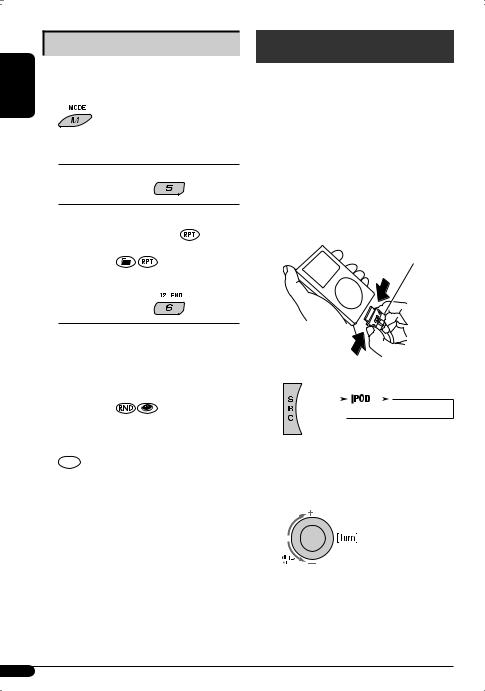
Selecting the playback modes
ENGLISH |
You can use only one of the following playback modes |
|
|
|
at a time. |
|
1 |
2Select your desired playback mode.
7 Repeat play 


Mode |
Plays repeatedly |
TRK RPT |
: The current track. |
FLDR RPT * |
: |
All tracks of the current folder. |
RPT OFF |
: |
Cancels. |
|
|
|
7 Random play
iPod operations
You can play songs from an Apple iPod through this unit by connecting it with the supplied connection cable for iPod.
•Disconnecting the iPod will also stop playback. Press SRC to listen to another playback source.
•For connection, see Installation/Connection Manual (separate volume).
•For details, refer also to the manual supplied with your iPod.
~ Connect an iPod.
Connection cable for iPod
Mode |
Plays at random |
FLDR RND * : All tracks of the current folder, then tracks of the next folder and so on. 
DISC RND : All tracks of the current disc.
If an iPod has been connected...
RND OFF |
: Cancels. |
|
|
|
|
|
|
|
|
|
|
|
|||
|
|
|
|
|
|
||
* Only while playing an MP3 or a WMA disc. |
Playback starts automatically from where it has |
||||||
: Corresponding indicator lights up on |
|||||||
been paused previously. |
|||||||
|
the display |
Ÿ Adjust the volume. |
|||||
|
|
||||||
! Adjust the sound as you want. (See page 12.)
10
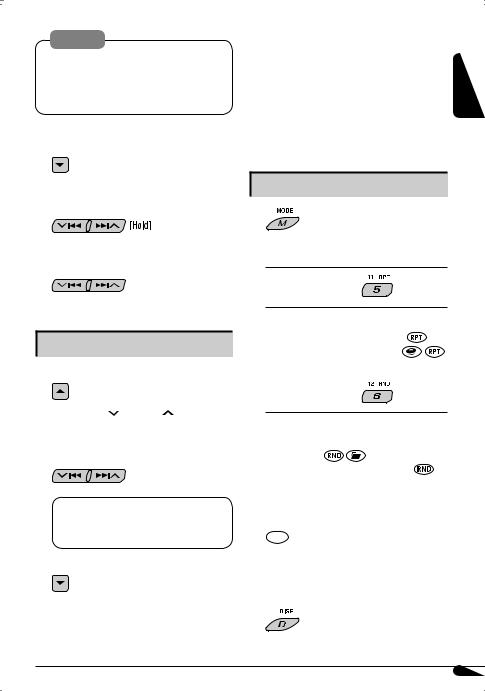
Caution:
•Avoid using the iPod if it might hinder your safety driving.
•Make sure all important data has been backed up to avoid losing the data.
To pause playback
To resume playback, press the button again.
To fast-forward or reverse the track
To go to the next or previous tracks
•If the selected item has another layer, you will enter the layer. Repeat steps 2 and 3 until the desired track is played (see page 19).
•Holding  4/¢
4/¢ can skip 10 items at a time.
can skip 10 items at a time.
* The menu selecting mode will be canceled:
–If no operations are done for about 5 seconds.
–When you confirm the selection of a track.
Selecting the playback modes
1
2 Select your desired playback mode.
7 Repeat play
ENGLISH
Selecting a track from the menu
1 Enter the main menu.
Now the 5/∞/ 4/¢ buttons work as the menu selecting buttons*.
2 Select the desired menu.
PLAYLIST ÔARTISTS ÔALBUMS Ô SONGS ÔGENRES ÔCOMPOSER Ô
(back to the beginning)
3 Confirm the selection.
To move back to the previous menu, press 5.
•If a track is selected, playback starts automatically.
Mode |
|
Playback functions (as on iPod) |
ONE RPT |
: Same as “Repeat One.” |
|
All RPT |
: |
Same as “Repeat All.” |
RPT OFF |
: |
Cancels. |
|
||
7 Random play |
||
Mode |
|
Playback functions (as on iPod) |
ALBM RND * : |
Same as “Shuffle Albums.” |
|
SONG RND |
: |
Same as “Shuffle Songs.” |
RND OFF |
: |
Cancels. |
|
|
|
*Functions only if you select “ALL” in “ALBUMS” of the main “MENU.”
: Corresponding indicator lights up on the display
To check other information while listening to an iPod
11
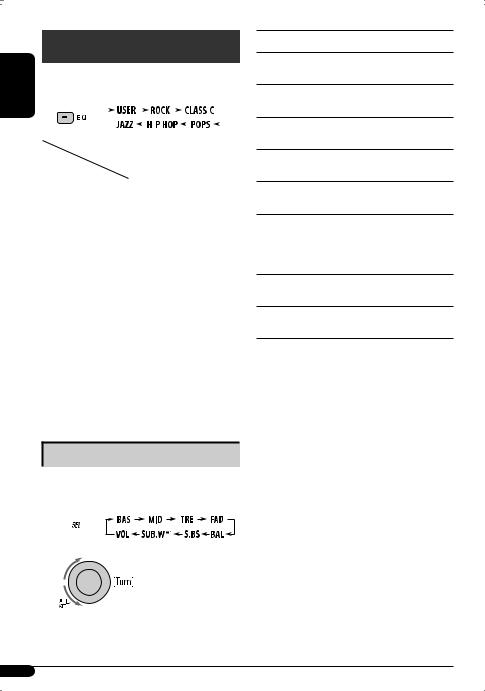
Sound adjustments
ENGLISH |
You can select a preset sound mode suitable to the |
||||||||||||||||||
|
|||||||||||||||||||
|
music genre (iEQ: intelligent equalizer). |
|
|
|
|
|
|
|
|||||||||||
|
|
|
|
|
|
|
|
|
|
|
|
|
|
|
|
|
|
|
|
|
|
|
|
|
|
|
|
|
|
|
|
|
|
|
|
|
|
|
|
|
|
|
|
|
|
|
|
|
|
|
|
|
|
|
|
|
|
|
|
|
Preset values |
BAS*1 |
MID*2 |
TRE*3 |
S.BS*4 |
||||||||||||||
|
Indication (For) |
||||||||||||||||||
|
|
|
|
|
|
|
|
|
|
|
|
|
|
|
|
||||
|
USER |
00 |
|
|
00 |
|
|
00 |
|
|
|
OFF |
|||||||
|
(Flat sound) |
|
|
|
|
|
|
|
|||||||||||
|
|
|
|
|
|
|
|
|
|
|
|
|
|
|
|
||||
|
|
|
|
|
|
|
|
|
|
|
|
|
|
|
|
|
|
|
|
|
ROCK |
+03 |
|
00 |
|
|
+02 |
|
|
|
ON |
||||||||
|
(Rock or disco music) |
|
|
|
|
|
|
||||||||||||
|
|
|
|
|
|
|
|
|
|
|
|
|
|
|
|
||||
|
|
|
|
|
|
|
|
|
|
|
|
|
|
|
|
|
|
|
|
|
CLASSIC |
+01 |
|
00 |
|
|
+03 |
|
|
|
OFF |
||||||||
|
(Classical music) |
|
|
|
|
|
|
||||||||||||
|
|
|
|
|
|
|
|
|
|
|
|
|
|
|
|
||||
|
|
|
|
|
|
|
|
|
|
|
|
|
|
|
|
|
|
|
|
|
POPS |
+02 |
|
+01 |
|
|
+02 |
|
|
|
OFF |
||||||||
|
(Light music) |
|
|
|
|
|
|
||||||||||||
|
|
|
|
|
|
|
|
|
|
|
|
|
|
|
|
||||
|
|
|
|
|
|
|
|
|
|
|
|
|
|
|
|
|
|
|
|
|
HIP HOP |
+04 |
|
–02 |
+01 |
|
|
|
ON |
||||||||||
|
(Funk or rap music) |
|
|
|
|
||||||||||||||
|
|
|
|
|
|
|
|
|
|
|
|
|
|
|
|
||||
|
|
|
|
|
|
|
|
|
|
|
|
|
|
|
|
|
|
|
|
|
JAZZ |
+03 |
|
00 |
|
|
+03 |
|
|
|
OFF |
||||||||
|
(Jazz music) |
|
|
|
|
|
|
||||||||||||
|
|
|
|
|
|
|
|
|
|
|
|
|
|
|
|
||||
|
|
|
|
|
|
|
|
|
|
|
|
|
|
|
|
|
|
|
|
*1 : Bass; *2 : Mid-range; *3 : Treble; *4 : Super bass
Adjusting the sound
You can adjust the sound characteristics to your preference.
1 
2
Indication, [Range]
BAS *2 (bass), [–06 to +06]
Adjust the bass.
MID *2 (mid-range), [–06 to +06]
Adjust the mid-range frequencies sound level.
TRE *2 (treble), [–06 to +06]
Adjust the treble.
FAD *3 (fader), [R06 to F06]
Adjust the front and rear speaker balance.
BAL *4 (balance), [L06 to R06]
Adjust the left and right speaker balance.
S.BS *2 (super bass), [S.BS ON or S.BS OFF], [01 to 05, initial: 03] *5
Maintain the richness and fullness of the bass sound regardless of how low you set the volume.
SUB.W *1 (subwoofer), [00 to 08, initial: 04] Adjust the subwoofer output level.
VOL (volume), [00 to 30 or 50 *6]
Adjust the volume.
*1 Displayed only when “L/O MODE” is set to “WOOFER” (see page 14).
*2 When you adjust the bass, mid-range, treble, or super bass, the adjustment you have made is stored for the currently selected sound mode (iEQ) including “USER.”
*3 If you are using a two-speaker system, set the fader level to “00.”
*4 This adjustment will not affect the subwoofer output. *5 Range adjustment for super bass is adjustable only
when it is set to “S.BS ON.“
*6 Depending on the amplifier gain control setting. (See page 14 for details.)
12
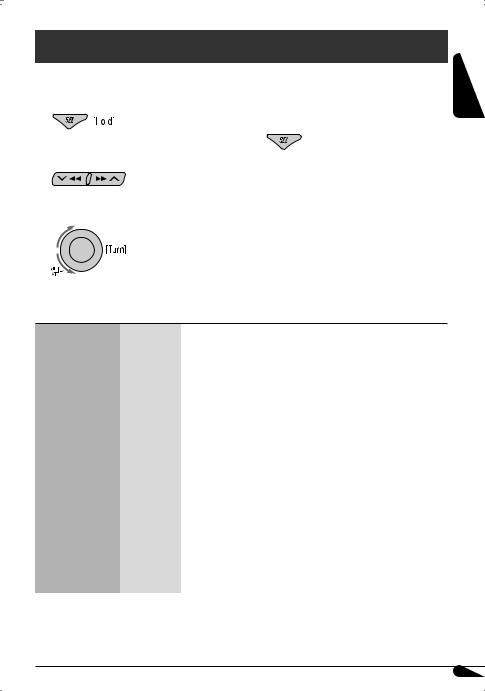
General settings — PSM
You can change PSM (Preferred Setting Mode) items |
4 |
Repeat steps 2 and 3 to adjust other PSM |
|||
listed in the table that follows. |
|
items if necessary. |
|||
|
|
|
|
|
|
1 |
|
|
|
5 |
Finish the procedure. |
|
|
|
|||
2 |
Select a PSM item. |
|
|
||
3 |
|
|
|
|
|
|
|
|
|
|
|
Adjust the PSM item selected. |
|
|
|||
ENGLISH
Indications |
Item |
Setting, [reference page] |
||
|
( |
|
: Initial) |
|
|
|
|
|
|
DEMO |
• |
DEMO ON |
: Display demonstration will be activated automatically if no operation is |
|
Display |
|
|
|
done for about 20 seconds, [6]. |
demonstration |
• |
DEMO OFF |
: Cancels. |
|
|
|
|
|
|
CLK DISP *1 |
• |
ON |
: Clock time is shown on the display at all times when the power is |
|
Clock display |
|
|
|
turned off. |
|
• |
OFF |
: Cancels; pressing D DISP will show the clock time for about 5 seconds |
|
|
|
|
|
when the power is turned off, [6]. |
|
|
|
|
|
CLOCK H |
1 – 12 |
[Initial: 1 (1:00)], [6] |
||
Hour adjustment |
|
|
|
|
|
|
|
|
|
CLOCK M |
00 – 59 |
[Initial: 00 (1:00)], [6] |
||
Minute adjustment |
|
|
|
|
|
|
|
|
|
DIMMER |
• |
AUTO |
: Dims the display when you turn on the headlights. |
|
Dimmer |
• |
ON |
: Activates dimmer. |
|
|
• |
OFF |
: Cancels. |
|
|
|
|
|
|
*1 If the power supply is not interrupted by turning off the ignition key of your car, it is recommended to select “OFF” to save the car’s battery.
Continued on the next page
13

ENGLISH
Indications |
Item |
Setting, [reference page] |
|||
|
( |
|
: Initial) |
|
|
|
|
|
|
|
|
SCROLL *2 |
• |
ONCE |
: |
Scrolls the track information once. |
|
Scroll |
• |
AUTO |
: |
Repeats scrolling (at 5-second intervals). |
|
|
• |
OFF |
: |
Cancels. |
|
|
|
|
|
• |
Pressing D DISP for more than one second can scroll the display |
|
|
|
|
|
regardless of the setting. |
|
|
|
|
|
|
L/O MODE |
• |
REAR |
: |
Select if both the LINE OUT terminals are used for connecting the |
|
Line output mode |
|
|
|
|
speakers (through an external amplifier). |
|
• |
WOOFER |
: |
Select if the REAR LINE OUT terminals are used for connecting a |
|
|
|
|
|
|
subwoofer (through an external amplifier). |
|
|
|
|
|
|
WOOFER *3 |
• |
LOW |
: |
Frequencies lower than 90 Hz are sent to the subwoofer. |
|
Subwoofer cutoff |
• |
MID |
: |
Frequencies lower than 135 Hz are sent to the subwoofer. |
|
frequency |
• |
HIGH |
: |
Frequencies lower than 180 Hz are sent to the subwoofer. |
|
|
|
|
|
|
|
AUX ADJ |
A.ADJ 00 |
: |
Adjust the auxiliary input level to avoid the sudden increase of the |
||
Auxiliary input level |
— A.ADJ 05 |
|
output level when changing the source from external component |
||
adjustment |
|
|
|
|
connected to the AUX input jack on the control panel. |
|
|
|
|
|
|
TAG DISP |
• |
TAG ON |
: Shows the Tag information while playing MP3/WMA tracks, [9]. |
||
Tag display |
• |
TAG OFF |
: |
Cancels. |
|
|
|
|
|
|
|
AMP GAIN |
• |
LOW PWR |
: VOL 00 – VOL 30 (Select this if the maximum power of the speaker is |
||
Amplifier gain |
|
|
|
|
less than 50 W to prevent damaging the speaker.) |
control |
• |
HIGH PWR |
: VOL 00 – VOL 50 |
||
|
|
|
|
|
|
AREA |
• |
AREA US |
: |
When using in North/Central/South America. AM/FM intervals are set |
|
Tuner channel |
|
|
|
|
to 10 kHz/200 kHz. |
interval |
• |
AREA EU |
: |
When using in any other areas except North/Central/South America. |
|
|
|
|
|
|
AM/FM intervals are set to 9 kHz/50 kHz (100 kHz during auto search). |
|
• |
AREA SA |
: |
When using in South American countries. AM/FM intervals are set to |
|
|
|
|
|
|
10 kHz/100 kHz. |
|
|
|
|
|
|
IF BAND |
• |
AUTO |
: |
Increases the tuner selectivity to reduce interference noises between |
|
Intermediate |
|
|
|
|
close stations. (Stereo effect may be lost.) |
frequency band |
• |
WIDE |
: |
Subject to interference noises from adjacent stations, but sound |
|
|
|
|
|
|
quality will not be degraded and the stereo effect will remain. |
|
|
|
|
|
|
*2 Some characters or symbols will not be shown correctly (or will be blanked) on the display. *3 Displayed only when “L/O MODE” is set to “WOOFER.”
14
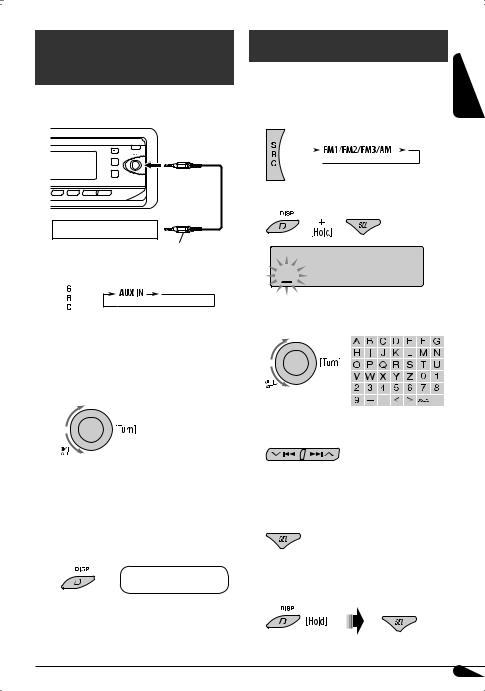
External component operations
You can connect an external component to the AUX (auxiliary) input jack on the control panel.
Portable MD player, etc
Stereo mini plug
~ 
ŸTurn on the connected component and start playing the source.
! Adjust the volume.
⁄Adjust the sound as you want. (See page 12.)
To check other information while listening to an external component
Clock ÔAUX IN
Title assignment
You can assign names to 30 station frequencies (FM and |
ENGLISH |
|||||
|
||||||
AM) and up to 8 characters for each station name. |
|
|||||
1 Select FM/AM. |
|
|||||
|
|
|
|
|
|
|
|
|
|
|
|
|
|
2 Show the title entry screen.
3Assign a title.
1 Select a character.
2Move to the next (or previous) character position.
3Repeat steps 1and 2until you finish entering the title.
4 Finish the procedure.
To erase the entire title
In step 2 above...
15

ENGLISH
More about this unit
Basic operations 
Turning on the power
•By pressing SRC on the unit, you can also turn on the power. If the source is ready, playback also starts.
Turning off the power
•If you turn off the power while listening to a track, playback starts from where it has been stopped previously, next time you turn on the power.
General
•If you change the source while listening to a disc or an iPod, playback stops.
Next time you select “CD” or “IPOD” as the playback source, playback starts from where it has been stopped/paused previously.
•After ejecting a disc or disconnecting an iPod, “NO DISC” or “NO IPOD” appears and you cannot operate some of the buttons. Insert another disc, reconnect an iPod, or press SRC to select another playback source.
Tuner operations 
Storing stations in memory
•During SSM search...
–All previously stored stations are erased and stations are stored newly.
–Received stations are preset in No. 1 (lowest frequency) to No. 6 (highest frequency).
–When SSM is over, the station stored in No. 1 will be automatically tuned in.
•When storing a station manually, the previously preset station is erased when a new station is stored in the same preset number.
Disc operations 
Caution for DualDisc playback
•The Non-DVD side of a “DualDisc” does not comply with the “Compact Disc Digital Audio” standard. Therefore, the use of Non-DVD side of a DualDisc on this product may not be recommended.
General
•This unit has been designed to reproduce CDs/CD Texts, and CD-Rs (Recordable)/CD-RWs (Rewritable) in audio CD (CD-DA), MP3 and WMA formats.
•When a disc is inserted upside down, “PLEASE” and “EJECT” appear alternately on the display. Press 0to eject the disc.
•MP3 and WMA “tracks” (words “file” and “track” are used interchangeably) are recorded in “folders.”
•While fast-forwarding or reversing on an MP3 or WMA disc, you can only hear intermittent sounds.
Playing a CD-R or CD-RW
•Use only “finalized” CD-Rs or CD-RWs.
•This unit can play back only files of the same type which are first detected if a disc includes both audio CD (CD-DA) files and MP3/WMA files.
•This unit can play back multi-session discs; however, unclosed sessions will be skipped while playing.
•Some CD-Rs or CD-RWs may not play back on this unit because of their disc characteristics, or for the following reasons:
–Discs are dirty or scratched.
–Moisture condensation occurs on the lens inside the unit.
–The pickup lens inside the unit is dirty.
–CD-R/CD-RW on which the files are written with “Packet Write” method.
–There are improper recording conditions (missing data, etc.) or media conditions (stained, scratched, warped, etc.).
•CD-RWs may require a longer readout time since the reflectance of CD-RWs is lower than that of regular CDs.
16

•Do not use the following CD-Rs or CD-RWs:
–Discs with stickers, labels, or a protective seal stuck to the surface.
–Discs on which labels can be directly printed by an ink jet printer.
Using these discs under high temperatures or high humidities may cause malfunctions or damage to the unit.
Playing an MP3/WMA disc
•This unit can play back MP3/WMA files with the extension code <.mp3> or <.wma> (regardless of the letter case—upper/lower).
•This unit can show the names of albums, artists (performer), and Tag (Version 1.0, 1.1, 2.2, 2.3, or 2.4) for MP3 files and for WMA files.
•This unit can display only one-byte characters. No other characters can be correctly displayed.
•This unit can play back MP3/WMA files meeting the conditions below:
–Bit rate: 8 kbps — 320 kbps
–Sampling frequency:
48 kHz, 44.1 kHz, 32 kHz (for MPEG-1) 24 kHz, 22.05 kHz, 16 kHz (for MPEG-2)
–Disc format: ISO 9660 Level 1/ Level 2, Romeo, Joliet, Windows long file name
•The maximum number of characters for file/folder names vary among the disc format used (includes 4 extension characters—<.mp3> or <.wma>).
–ISO 9660 Level 1: up to 12 characters
–ISO 9660 Level 2: up to 31 characters
–Romeo: up to 128 characters
–Joliet: up to 64 characters
–Windows long file name: up to 128 characters
•This unit can recognize a total of 512 files, of 200 folders, and of 8 hierarchies.
•This unit can play back files recorded in VBR (variable bit rate).
Files recorded in VBR have a discrepancy in elapsed time display, and do not show the actual elapsed time. Especially, after performing the search function, this difference becomes noticeable.
•This unit cannot play back the following files:
–MP3 files encoded with MP3i and MP3 PRO format.
–MP3 files encoded in an inappropriate format.
–MP3 files encoded with Layer 1/2.
–WMA files encoded with lossless, professional, and voice format.
–WMA files which are not based upon Windows Media® Audio.
–WMA files copy-protected with DRM.
–Files which have the data such as AIFF, ATRAC3, etc.
•The search function works but search speed is not constant.
Ejecting a disc
•If the ejected disc is not removed within 15 seconds, the disc is automatically inserted again into the loading slot to protect it from dust. Playback starts automatically.
iPod operations 
Controllable iPod |
Software version |
|
|
iPod with dock connector |
2.3 or later |
(3rd Generation) |
|
iPod with Click Wheel |
3.1 or later |
(4th Generation) |
|
|
|
iPod mini |
1.4 or later |
|
|
iPod photo |
1.2 or later |
|
|
iPod nano |
1.0 or later |
|
|
iPod with Video |
1.0 or later |
(5th Generation) |
|
|
|
•If your iPod software version is older than those mentioned above, you may not be able to control the iPod properly. Update your iPod to the latest software version before using it with this unit.
–You can check the software version of your iPod from “About” in the “Setting” menu of the iPod.
–For details about updating your iPod, visit <http://www.apple.com>.
ENGLISH
Continued on the next page
17

ENGLISH
•When you turn on this unit, the iPod is charged through this unit.
•While the iPod is connected, all operations from the iPod are disabled. Perform all operations from this unit.
•While connecting an iPod with Video:
–No video shows on the iPod’s display or the external monitor (only the audio part is available).
–It is not possible to browse video files on the “Video“ menu. (If you connect the iPod during playback or pausing of a video file, resuming playback will not work.)
•iPod shuffle is not controllable.
•You can control the iPod from this unit when “JVC” or “ ” appears on the iPod display.
” appears on the iPod display.
•The songs order displayed on the selecting menu of this unit may differ from the iPod.
•If playback is stopped, select a track from the selecting menu or press ∞.
•The text information may not be displayed correctly.
–Some characters such as accented letters cannot be shown correctly on the display.
–Depends on the condition of communication between the iPod and the unit.
•If the text information includes more than 8 characters, it scrolls on the display. This unit can display up to 40 characters.
Title assignment 
•If you try to assign titles to more than 30 station frequencies, “NAMEFULL” appears. Delete unwanted titles before assignment.
General settings—PSM 
•“AUTO” setting for “DIMMER” may not work correctly on some vehicles, particularly on those having a control dial for dimming.
In this case, change “DIMMER” setting to any other than “AUTO.”
•If you change the “AMP GAIN” setting from
“HIGH PWR” to “LOW PWR” while the volume level is set higher than “VOL 30,” the unit automatically changes the volume level to “VOL 30.”
18
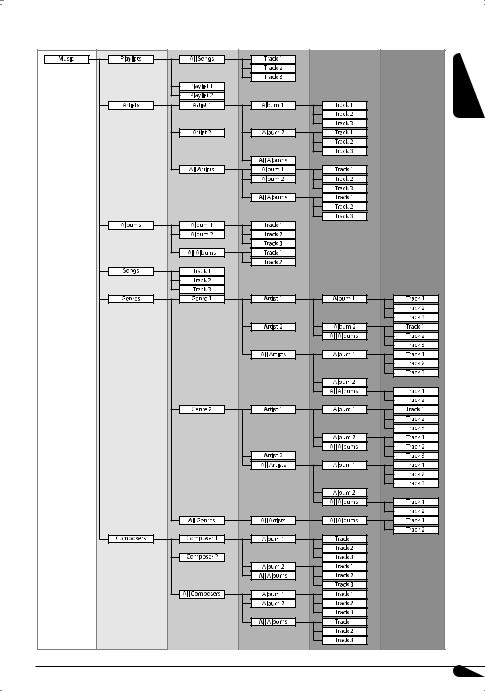
Hierarchical structure of file searching when an iPod is connected
ENGLISH |
19 |
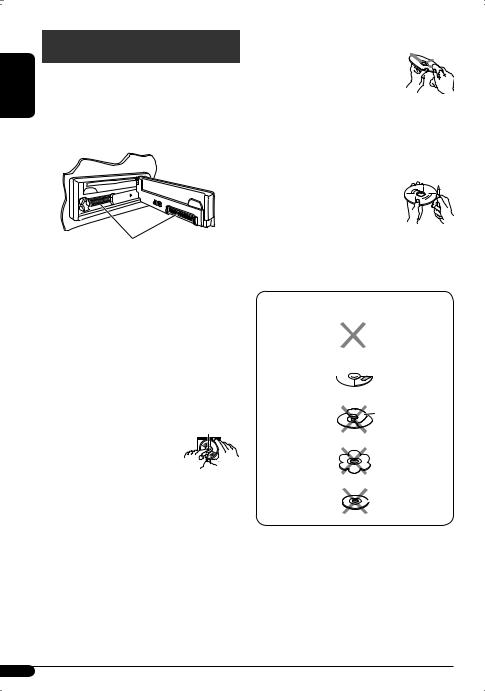
ENGLISH
Maintenance
 How to clean the connectors
How to clean the connectors
Frequent detachment will deteriorate the connectors. To minimize this possibility, periodically wipe the connectors with a cotton swab or cloth moistened with alcohol, being careful not to damage the connectors.
 To keep discs clean
To keep discs clean
A dirty disc may not play correctly.
If a disc does become dirty, wipe it with a soft cloth in a straight line from center to edge.
•Do not use any solvent (for example, conventional record cleaner, spray, thinner, benzine, etc.) to clean discs.
 To play new discs
To play new discs
New discs may have some rough spots around the inner and outer edges. If such a disc is used, this unit may reject the disc.
To remove these rough spots, rub the edges with a
Connector
pencil or ball-point pen, etc.
 Moisture condensation
Moisture condensation
Moisture may condense on the lens inside the unit in the following cases:
•After starting the heater in the car.
•If it becomes very humid inside the car.
Should this occur, the unit may malfunction. In this case, eject the disc and leave the unit turned on for a few hours until the moisture evaporates.
 How to handle discs
How to handle discs
When removing a disc from its |
Center holder |
case, press down the center holder |
|
of the case and lift the disc out, |
|
holding it by the edges. |
|
• Always hold the disc by the edges. Do not touch its recording surface.
When storing a disc into its case, gently insert the disc around the center holder (with the printed surface facing up).
• Make sure to store discs into the cases after use.
Do not use the following discs:
Warped disc 
Sticker 

 Sticker residue
Sticker residue
Stick-on label
 Unusual shape
Unusual shape
 Single CD—
Single CD—
8 cm (3-3/16”) disc
20

Troubleshooting
What appears to be trouble is not always serious. Check the following points before calling a service center.
|
|
Symptoms |
Remedies/Causes |
|
General |
|
• Sound cannot be heard from the speakers. |
• Adjust the volume to the optimum level. |
|
|
|
• Check the cords and connections. |
||
|
|
|
||
|
|
|
|
|
|
|
• The unit does not work at all. |
Reset the unit (see page 3). |
|
|
|
|
|
|
FM/AM |
|
• SSM automatic presetting does not work. |
Store stations manually. |
|
|
|
|
||
• Static noise while listening to the radio. |
Connect the antenna firmly. |
|||
|
|
|||
|
|
|
|
|
|
|
• Disc cannot be played back. |
Insert the disc correctly. |
|
|
|
|
|
|
|
|
• CD-R/CD-RW cannot be played back. |
• Insert a finalized CD-R/CD-RW. |
|
|
|
• Tracks on the CD-R/CD-RW cannot be |
• Finalize the CD-R/CD-RW with the component which |
|
playback |
|
skipped. |
you used for recording. |
|
|
|
|
||
• Disc can neither be played back nor ejected. |
• Unlock the disc (see page 9). |
|||
|
|
|||
Disc |
|
|
• Eject the disc forcibly (see page 3). |
|
|
|
|
||
|
• Disc sound is sometimes interrupted. |
• Stop playback while driving on rough roads. |
||
|
|
|||
|
|
|
• Change the disc. |
|
|
|
|
• Check the cords and connections. |
|
|
|
|
|
|
|
|
• “NO DISC” appears on the display. |
Insert a playable disc into the loading slot. |
|
|
|
|
|
|
|
|
• Disc cannot be played back. |
• Use a disc with MP3/WMA tracks recorded in the |
|
|
|
|
format compliant with ISO 9660 Level 1, Level 2, |
|
playback |
|
|
Romeo, or Joliet. |
|
|
|
• Add the extension code <.mp3> or <.wma> to the |
||
|
|
|
||
|
|
|
file names. |
|
MP3/WMA |
|
|
|
|
|
• Noise is generated. |
Skip to another track or change the disc. (Do not add the |
||
|
|
|||
|
|
|
extension code <.mp3> or <.wma> to non-MP3 or |
|
|
|
|
WMA tracks.) |
|
|
|
|
|
|
|
|
• A longer readout time is required (“CHECK” |
Do not use too many hierarchies and folders. |
|
|
|
keeps flashing on the display). |
|
|
|
|
|
|
ENGLISH
Continued on the next page
21
